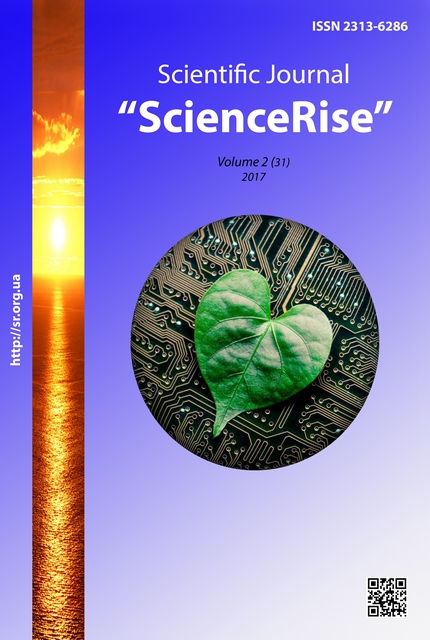Peculiarites of yield capacity formation and quality analysis of false flax seeds dependind on fertilizers and means of plant protection
DOI:
https://doi.org/10.15587/2313-8416.2017.93804Keywords:
false flax, intensification of technology, fertilizers, herbicides, fungicides, insecticides, yield capacity, qualityAbstract
The results of studies of the intensification of false flax cultivation technology due to the application of herbicide Butizan 400, insecticide Fastak, fertilizers N120P60K120, fungicide Caramba and Piktor, fertilizers Intermag oil and Intermag Bor, leaf application of MgSO4 are given in the article. It is established that the application of plant protection products and fertilizers provided the yield increase from 0.78 t/ha to 3.04 t/ha on the control or to 2.26 t/ha. Oil content in seeds increased from 42.6 % to 47.0 %
References
Shpaar, D. (2012). Raps i surepica: vyrashhivanie, uborka, hranenie i ispol'zovanie. Kyiv: Izdatel'skij dom "Zerno", 368.
Gorbatjuk, E. M., Garbar, L. A. (2011). Vplyv zabur'janenosti na formuvannja produktyvnosti ripaku. SWorld. Available at: http://www.sworld.com.ua/index.php/ru/agriculture-212/agriculture-animal-husbandry-and-forestry-212/13671-212-770
Vedmedieva, K. (2016). Perspektyvni oliini. The Ukraine Farmer, 1, 20.
Buchynskyi, I. M., Lykhochvor, V. V., Kovalets, O. V. (2011). Efektyvnist ta selektyvnist dii herbitsydu Halera ta Halera Super za vyroshchuvannia oliinykh kultur. Visnyk Lvivskoho natsionalnoho ahrarnoho universytetu: ahronomiia, 15, 154–159.
Kataloh 2016 roku zasobiv zakhystu roslyn kompanii BASF (2016). BASF. Available at: http://www.agro.basf.ua/agroportal/search/uk/search.action
Storchous, I. (2012). Zakhyst ripaku vid bur´yaniv. Ahrobiznes sohodni, 13, 24–26.
Moskva, I. S., Hamaiunova, V. V. (2016). Stan ta perspektyvy vyroshchuvannia ryzhiiu na pivdni Stepu Ukrainy. Visnyk ahrarnoi nauky Prychornomor´ya, 1, 99–109.
Demydas, H. I., Kvitko, H. P., Get'man, N. Ja. (2011). Ryzhii posivnyi – oliina kultura alternatyva ripaku yaromu dlia vyrobnytstva biodyzelia. Zbirnyk naukovykh prats VNAU, 8, 3–8.
Yevtushenko, M. D., Mariutin, F. M., Turenko, V. P., Zherebko, V. M., Sekun, M. P. (2004). Fitofarmakolohiia. Kyiv: Vyshcha osvita, 432.
Pluzhnykova, Y. Y., Smyrnov, A. A., Kryushyn, N. V., Prahov, V. A., Vel'myseva, L. E. (2016). Effektyvnost prymenenyia funhytsydov protyv osnovnukh boleznei ruzhyka posevnoho. Dostyzhenye nauky y tekhnyky APK, 30 (1), 44–47.
Serdiuk, O. A., Bochkareva, E. B., Pyven, V. H. (2011). Bolezny maslychnikh kultur semeistva kapustnikh v uslovyiakh Krasnodarskoho kraia. Zashchyta y karantyn rastenyi, 3, 50–53.
Prakhova, T. Ya. (2013). Rizhyk posevnoi (Camelina sativa (L.) Crantz. Penza: RYO PHSKhA, 209.
Downloads
Published
Issue
Section
License
Copyright (c) 2017 Андрій Миколайович Лихочвор

This work is licensed under a Creative Commons Attribution 4.0 International License.
Our journal abides by the Creative Commons CC BY copyright rights and permissions for open access journals.
Authors, who are published in this journal, agree to the following conditions:
1. The authors reserve the right to authorship of the work and pass the first publication right of this work to the journal under the terms of a Creative Commons CC BY, which allows others to freely distribute the published research with the obligatory reference to the authors of the original work and the first publication of the work in this journal.
2. The authors have the right to conclude separate supplement agreements that relate to non-exclusive work distribution in the form in which it has been published by the journal (for example, to upload the work to the online storage of the journal or publish it as part of a monograph), provided that the reference to the first publication of the work in this journal is included.

